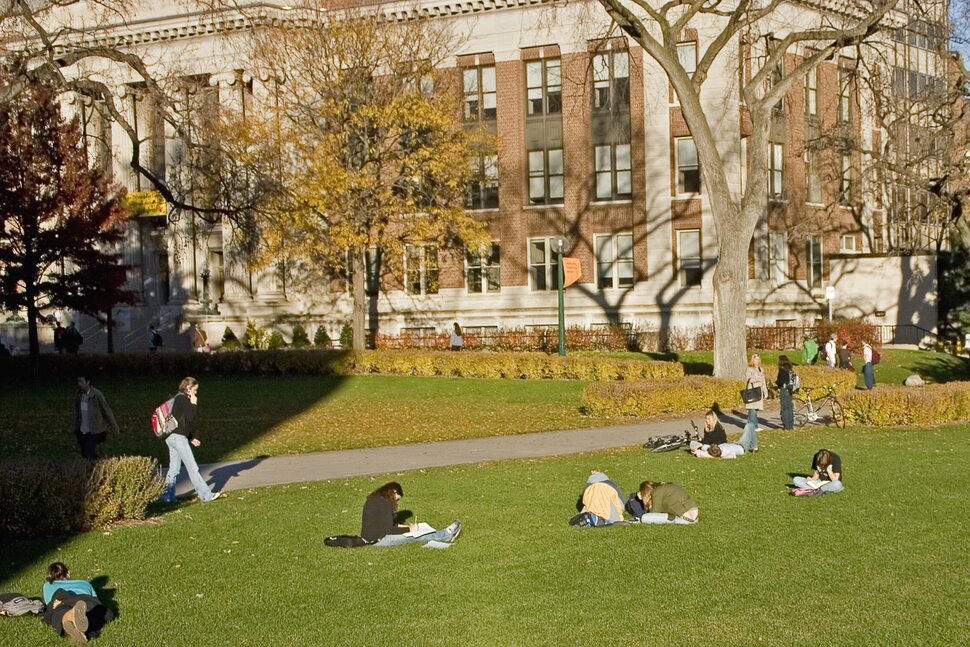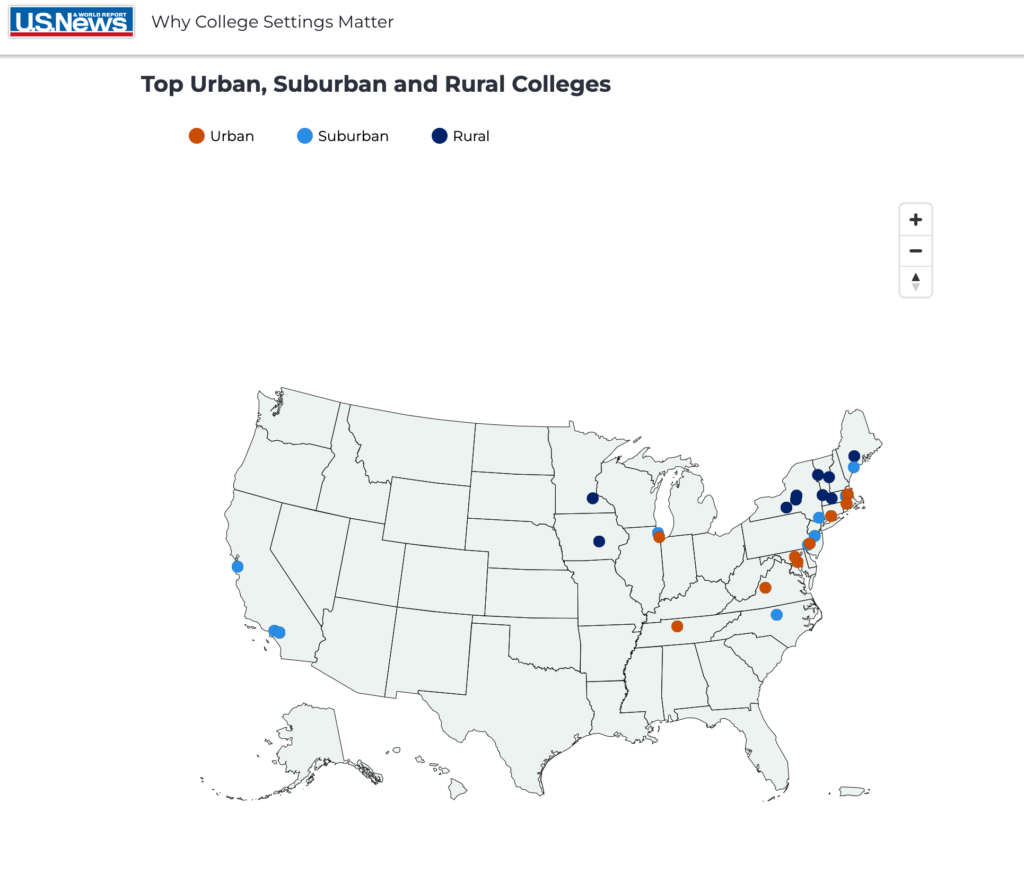Urban, Suburban and Rural Colleges: How to Choose
Urban, Suburban and Rural Colleges: How to Choose
By Cole Claybourn, US News & World Report I March 28, 2023

Location is one of the many important factors prospective students weigh when choosing where to go to college.
This decision isn’t just about how far they’ll be from home – it’s also about the kind of place they’re in, whether that’s a big city, a small college town or the quiet countryside.
Each setting – urban, suburban and rural – can offer profound learning and cultural experiences. But that doesn’t mean each location would be a natural fit for every student. Some may find themselves overwhelmed by the hustle and bustle of big city life, while others long for more activities than they might experience on a secluded rural campus.
“When people are looking at places, I think the geographical area of the country is important. That’s usually the first determining factor,” says Matt Woodworth, founder of college admissions consulting company Woodworth Prep. “One of the things I find interesting is that it’s also one of the few areas where kids and parents will not quite have the same view.”
Why College Setting Matters
There are a variety of factors to consider when it comes to a college setting, experts say. A school situated in a downtown area can provide a vastly different experience than one at a more isolated campus in a small town or suburban area.
[
READ: What to Consider When Visiting a College Town. ]
“It’s important you feel comfortable at a college of your choice and the setting of a college could impact what your comfort level is,” Eric Nichols, vice president for enrollment management at Loyola University Maryland, wrote in an email. “Do you want to live in a big city, just be adjacent to (a) city while having a residential campus experience? Or are you comfortable with a small college town that is tucked away from a metropolitan area?”
He adds that students often spend more time on campus than they initially expect.
Students typically have an idea of what their ideal lifestyle is and it can be helpful to choose a college that will cater to that, Woodworth says.
“It tends to go two directions,” he says. “What I find a lot of times is that kids want to repeat the environment that they grew up in. If they grow up in a small town, they want to go to a place in a small town. If they grow up rural, they want to go somewhere rural.”
By “keeping with what’s familiar,” students are able to enter college more comfortably, Woodworth says.
U.S. News asks colleges to self-report their settings in its annual survey. The below map shows the top-ranked schools by setting – rural, suburban or city/urban.

Finding the Right College Setting
Students should also consider setting when thinking about opportunities beyond the classroom, says Mandee Heller Adler, founder and president of International College Counselors. Many students tend to find jobs and internships in or near the city where they attend college, and some end up staying and working in that area after building personal and professional connections.
“Another factor to think about is opportunities for work experience and internships during the school year,” Heller Adler wrote in an email. “The choices are slimmer in a small city as compared to New York City, Washington D.C., or Los Angeles, for example.”[
READ: How to Make a College List. ]
Some fields are particularly location-specific. “If you’re thinking about going into something like tech, it’s going to be much more advantageous for you to be near Silicon Valley,” Woodworth says, “but the other problem is that it is going to cost a lot more to live in a city for four years while you’re in college. So you have to weigh that in, and that’s part of the college experience.”
On the other hand, students interested in fields like environmental science may see those opportunities in abundance in a more rural setting.
Heller Adler suggests also considering the activities you’d like to pursue outside of class. For instance, students interested in opportunities for outdoor recreation may lean toward rural settings, while urban colleges are likely to offer access to a greater range of cultural activities.
Adler encourages students to consider what on-campus activities are offered, noting that “urban campuses typically have less of an on-campus community.”
Visit Before Jumping to Conclusions
Just because a college is located in a certain city or area doesn’t mean the campus itself is a direct reflection of that geographic space. Colleges are like cities unto themselves, and what’s happening in the broader area may not necessarily be the experience on campus. Nichols encourages prospective students to go visit a college rather than letting a description of the setting determine their view.
“For example, a school may be located in a city but the actual location of the campus itself may be on the edge of town and the setting may feel more like a residential suburban neighborhood,” Nichols says. “Not all big city schools have campuses that spill into the downtown area. It’s another reminder to always take the time to visit the schools you are most interested (in) rather than make assumptions based on location.”
If students can’t visit in person, then taking a virtual college tour is the next best option, experts say.[
READ: 21 Places Worth Seeing on College Tours. ]
Though a college setting can give students a loose idea of what to expect, there are often unexpected twists. Take Loyola University Maryland. While located in Baltimore, the college has an arboretum on 80 acres that was recently recognized as having the largest trees in the state, which may not fit student preconceptions of an urban area.
“If you can’t get to the campuses yourself and get a real vibe for it, how do you figure that out?” asks Alex Boylan, executive producer and host of The College Tour, an internet-based television show that provides free classes and virtual tours of college campuses to help students in their college decision process. Its videos share first-hand accounts from students to give prospective students what they hope is an authentic feel of the campus. “I think it’s huge because the cultural fit really ties into that location of what you’re looking for.”
Regardless of where students go, experts say they should expect an adjustment because college is still a new environment in and of itself.
“Moving somewhere new and truly feeling comfortable in a new environment takes time,” Heller Adler says. “Whether a student makes a big jump from urban to rural, or if they’re staying in their home city, feeling out-of-sync for some time during the first year of college is completely normal.”
She encourages students to get involved with activities and student organizations, build their own community, try new things and develop a peer group to support them through college.
“If a student is having a rough time, they should not be afraid to reach out to someone they trust, such as an advisor, professor or peer,” she says. “In college, no one should feel alone. And if a student is truly unhappy and feeling out-of-place, there is always the option to transfer.”
Searching for a college? Get our complete rankings of Best Colleges.
